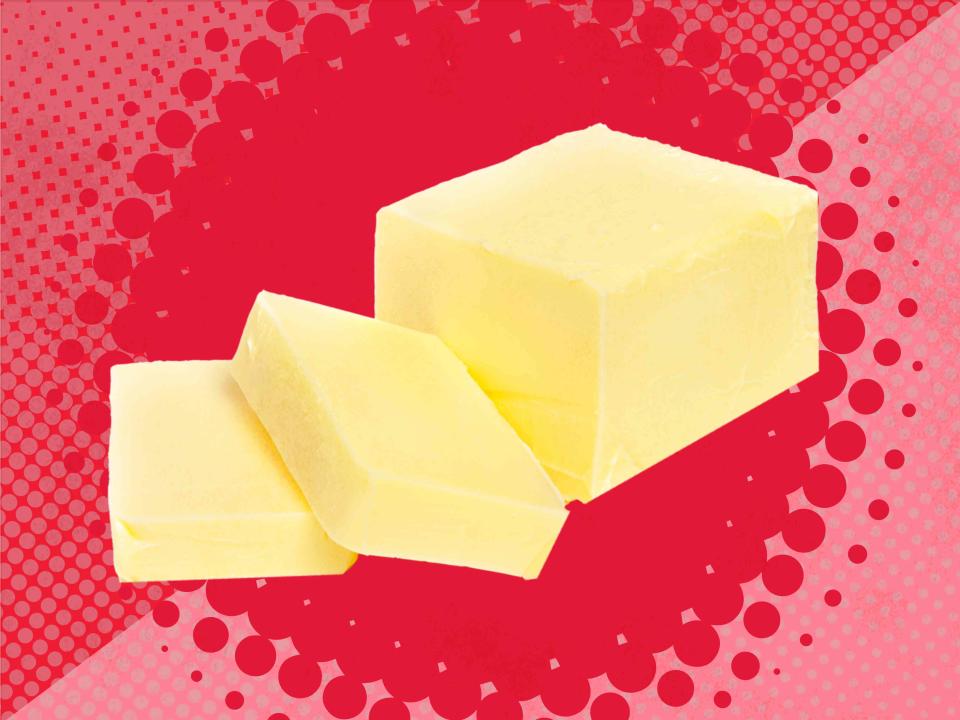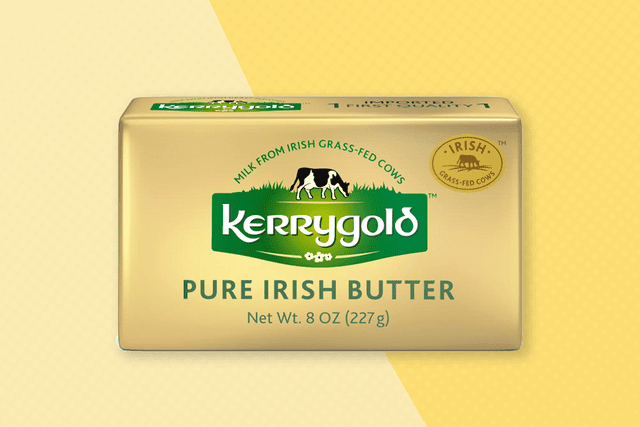I Asked 7 Chefs and They All Agree That This Is the Best Butter
It's our favorite, too.

Getty Images
You could certainly whip up a batch of homemade butter. But why make a mess of your kitchen when there are outstanding, easy-to-measure sticks in stock at your local supermarket? Settling on one brand is the hard part. We get it: The butter section of the dairy case can be as overwhelming as the cereal aisle. How do you even begin to narrow down the options?
To help you do just that, we reached out to chefs, bakers, cookbook authors, and culinary pros to help us hone in on the best of the best. A sneak preview of coming attractions: The victor just so happens to be Martha Stewart’s favorite butter (and Stanley Tucci's and Bobby Flay's... you get the idea). It’s also the brand that came out on top of the best dairy category in our 2024 Golden Cart Awards for groceries.
Read on to learn more about what food experts look for in their “best butter,” including whether salted or unsalted is your best bet. Then we’re revealing their selection for the best butter brand and are dishing about how to use it to make your sweet and savory creations richer and more delicious than ever.
Our Panel of Butter-Judging Chefs and Food Experts
Marino Bianchi, executive chef of Joe Muer Seafood in Nashville, Tennessee
Amy Eubanks, the Austin, Texas-based senior team leader of culinary development at Whole Foods Market
Sarah Fennel, the New York City-based founder of Broma Bakery and author "Sweet Tooth"
Dan Langan, Philadelphia, Pennsylvania-based author of "Bake Your Heart Out"
Jessica Entzel Nolan, Novato, California-based CEO, founder, and pastry chef for Doughpamine, a gourmet frozen cookie dough company
Vivek Surti, founder and owner of Tailor in Nashville, Tennessee
John Tesar, chef/owner of KNIFE Italian in Irving, Texas
Types of Butters
While you might think of butter brands as “toh-may-toh, toh-mah-toh,” there’s actually a big difference between the options available at major retailers. Based on our baking trials, we’ve determined that, yes, the kind you choose does make a noticeable difference in the finished product.
The most common types of butter available in the U.S. include:
American-style butter: Contains at least 80% butterfat, according to USDA standards.
Amish Butter: Usually slow-churned (for creaminess) and about 85% butterfat.
Cultured Butter: Created when live active cultures are introduced to cream before it’s churned, which results in a tangy quality similar to yogurt.
European Butter: Typically cultured, and includes at least 82% butterfat; due to having less water, European butters tend to have richer flavor than American butters.
Now that you know how butter categories are broken down, let’s dive into what chefs are seeking. Our panel chimed in with the following qualities as part of their best butter:
High butterfat content
Made with milk or cream from grass-fed cows, which “leads to butter that has a richer taste compared with butter made from cows raised in barn conditions,” says Fennel
Nationally-available brands for consistency, availability, and affordability
More yellow in color than pale and off-white
Free of additives or preservatives
Salted and unsalted options available
Salted or Unsalted?
Although they agreed on the best butter brand, our culinary panel was split about whether they preferred salted or unsalted butter.
Fennel and Langan swear by unsalted so they can add the exact amount of salt they prefer to their recipes. Nolan and Eubanks are on Team Salted for most occasions to layer on more flavor and because, as Eubanks admits, she “has a sweet and a salty tooth.”
Surti sits right at the happy medium, and confirms that both have their place: “I use unsalted for sweet things or for a cooking application so I can control the level of salt, but if I’m putting butter on bread or a biscuit, then I’m going with salted,” he says.
The Best Store-Bought Butter, According to Chefs

It’s unanimous: The best butter for sweet and savory applications is Kerrygold, our seven food pros agree. “It ticks every box for that classic ‘butter’ you think of in your head,” Fennel says.
Clocking in at 82% butterfat, Kerrygold butter has a creamy texture and offers “rich, complex, yet not overpowering flavor,” according to Eubanks. That’s all due to the fact that its base is made with dairy from Irish grass-fed cows. Plus, it’s beautifully golden in color, and “just an all-around good ingredient,” Surti says.
Since it’s available at large retailers like Costco, Target, and Walmart, Fennel is particularly fond of Kerrygold’s wide availability and fairly budget-friendly price compared to most fancy butters.
5 More Chef-Approved Butters
As much as the panelists swear by Kerrygold, if they were allowed to pick a runner-up, our crew of culinary experts confirmed that they would also be perfectly happy featuring the following butters in their recipes:
Southern-staple, small-batch Banner Butter
Velvety New Zealand-made Lewis Road Creamery Butter
Creamy and easy-blending Plugrà Premium European Style Butter
Herbaceous Challenge Butter
Fermented, complexly-flavored Vermont Creamery's Cultured Butter
How to Use Butter Like a Chef
If all of this butter banter has you ready to spread it on thick, consider one of our 50 of our most buttery recipes. Or try one of these chef-approved uses for Kerrygold butter (or your personal favorite butter brand, if you’re loyal to another):
Spread on bread. Since “the flavor can stand up on its own,” according to Nolan, one of the best ways to put a pat of room temp butter to good use is on bread or toast “with a touch of sea salt,” Tesar recommends.
In savory sauces. Bianchi, Tesar, Eubanks, and Nolan adore stirring together classic French butter sauces like beurre monté (butter emulsified with hot water) and beurre blanc (made with white wine, heavy cream, butter, shallots, and lemon juice) as a crown for grilled or roasted fish, seafood, or meat.
To finish a dish. As an even easier finishing touch, Surti swears by brushing melted butter over grilled chicken, steak, or fish as soon as it comes off the grill. Or toss melted butter with roasted potatoes just before serving.
To make brown butter. Eubanks makes batches of nutty brown butter (aka beurre noisette) with Kerrygold, then cools it and keeps it on hand in her refrigerator to use down the road. To follow her lead, simply warm butter in a saucepan over medium heat, stirring or swirling constantly, until the butter begins to smell toasty and turns light tan in color. Then you can use that intensely flavored, nutty goodness in recipes like Brown Butter Banana Bread, Bourbon Brown Butter Blondies, Brown Butter Frosting, or Roasted Cauliflower with Caper Brown Butter.
For compound butter. To take your morning toast to the next level, or to melt over grilled steak, chicken, or salmon, Eubanks adores making compound butter, which is essentially softened butter dressed up with herbs, spices, or other flavoring elements. Her favorite combination: Whipped softened butter, avocado, fresh lime juice, and a pinch of cumin. “It’s a bit indulgent but is a nice way to extend the life of an avocado,” that might be on the way out, Eubanks says. “I roll and freeze it and then slice it as needed.”
In baked goods, especially ones in which butter plays a major role. While it might feel like a splurge to invest in Kerrygold rather than your grocery store’s generic brand of butter for, say, brownies, our culinary panel definitely thinks that Irish butter is worth the extra few bucks when you’re crafting treats where butter’s flavor shines. Pie crusts, butter cookies, shortbreads, laminated doughs, and biscuits are among their top picks. “I bake with butter every day, so a high-quality butter is incredibly important to me, as it can completely change the outcome of my baked goods,” Fennel says.
Read the original article on All Recipes.


